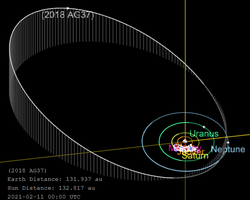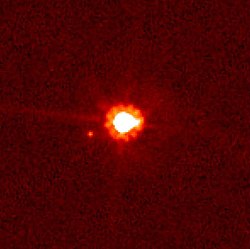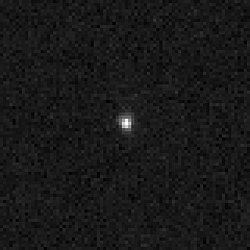List of Solar System objects most distant from the Sun
 From Wikipedia the free encyclopedia
From Wikipedia the free encyclopedia

Sun
Jupiter trojans (6,178)
Scattered disc (>300) Giant planets: J · S · U · N
Centaurs (44,000)
Kuiper belt (>1,000)
(scale in AU; epoch as of January 2026; # of objects in parentheses)
These Solar System minor planets are the furthest from the Sun as of January 2026[update]. The objects have been categorized by their approximate distance from the Sun on that date, and not by the calculated aphelion of their orbit. The list changes over time because the objects are moving in their orbits. Some objects are inbound and some are outbound. It would be difficult to detect long-distance comets if it were not for their comas, which become visible when heated by the Sun. Distances are measured in astronomical units (AU, Sun–Earth distances). The distances are not the minimum (perihelion) or the maximum (aphelion) that may be achieved by these objects in the future.
This list does not include near-parabolic comets of which many are known to be currently more than 100 AU (15 billion km) from the Sun, but are currently too far away to be observed by telescope. Trans-Neptunian objects are typically announced publicly months or years after their discovery, so as to make sure the orbit is correct before announcing it. Due to their greater distance from the Sun and slow movement across the sky, trans-Neptunian objects with observation arcs less than several years often have poorly constrained orbits. Particularly distant objects take several years of observations to establish a crude orbit solution before being announced. For instance, the most distant known trans-Neptunian object 2018 AG37 was discovered by Scott Sheppard in January 2018 but was announced three years later in February 2021.[1]
Notable objects
[edit]One particularly distant body is 90377 Sedna, which was discovered in November 2003. It has an extremely eccentric orbit that takes it to an aphelion of 937 AU.[2] It takes over 10,000 years to orbit, and during the next 50 years it will slowly move closer to the Sun as it comes to perihelion at a distance of 76 AU from the Sun.[3] Sedna is the largest known sednoid, a class of objects that play an important role in the Planet Nine hypothesis. The discovery of 2017 OF201 challenges the existence of hypothetical Planet Nine as its orbit is anti-aligned to the calculated orbit of Planet Nine. It is suggested that that hypothetical planet would have ejected 2017 OF201 from its present-day orbit over times scales of less than 100 million years, though it could be in a temporary orbit.[4][5]
Pluto (30–49 AU, about 34 AU in 2015) was the first Kuiper belt object to be discovered (1930) and is the largest known dwarf planet.
Gallery
[edit]- Notable trans-Neptunian objects
- Gemini North telescope images of 2018 AG37, the farthest known Solar System object as of 2026[update]
- Diagram of 2018 AG37's orbit, showing its location at aphelion
- Sedna viewed with Hubble Space Telescope, 2004
Known distant objects
[edit]This is a list of known objects at heliocentric distances of more than 80 AU. In theory, the Oort cloud could extend over 120,000 AU (2 ly) from the Sun.
| Object name | Distance from the Sun (AU)[7] | Radial velocity (AU/yr)[a][7] | Perihelion | Aphelion | Semimajor axis | Apparent magnitude | Absolute magnitude (H) | Discovery date[7] | Refs | |||||||||||||||||||||||||||||||||||||||||||||||||||||||||||||||||||||||||||||||||||||||||
|---|---|---|---|---|---|---|---|---|---|---|---|---|---|---|---|---|---|---|---|---|---|---|---|---|---|---|---|---|---|---|---|---|---|---|---|---|---|---|---|---|---|---|---|---|---|---|---|---|---|---|---|---|---|---|---|---|---|---|---|---|---|---|---|---|---|---|---|---|---|---|---|---|---|---|---|---|---|---|---|---|---|---|---|---|---|---|---|---|---|---|---|---|---|---|---|---|---|---|
| January 2026 | At discovery date | |||||||||||||||||||||||||||||||||||||||||||||||||||||||||||||||||||||||||||||||||||||||||||||||||
| Great Comet of 1680 (for comparison) | 262.2 | 1.16 | +0.47 | 0.006 | 889 | 444 | — | — | 1680-11-14 | [8] | ||||||||||||||||||||||||||||||||||||||||||||||||||||||||||||||||||||||||||||||||||||||||
| Voyager 1 (for comparison) | 169.2 | – | +3.56 | 8.79 | ∞ Hyperbolic | −3.22 | — | — | — | [9] | ||||||||||||||||||||||||||||||||||||||||||||||||||||||||||||||||||||||||||||||||||||||||
| Voyager 2 (for comparison) | 141.7 | – | +3.17 | 21.3 | ∞ Hyperbolic | −4.03 | — | — | — | [10] | ||||||||||||||||||||||||||||||||||||||||||||||||||||||||||||||||||||||||||||||||||||||||
| Pioneer 10 (for comparison) | 140.1 | – | +2.50 | 5.06 | ∞ Hyperbolic | –6.94 | — | — | — | [11] | ||||||||||||||||||||||||||||||||||||||||||||||||||||||||||||||||||||||||||||||||||||||||
| 2018 AG37 | 132.4 | 132.6 | +0.03 | 27.1 | 145.0 | 86.0 | 25.4 | 4.2 | 2018-01-15 | [12] | ||||||||||||||||||||||||||||||||||||||||||||||||||||||||||||||||||||||||||||||||||||||||
| 2018 VG18 | 123.9 | 123.4 | +0.05 | 37.8 | 123.9 | 81.3 | 24.6 | 3.7 | 2018-11-10 | [13] | ||||||||||||||||||||||||||||||||||||||||||||||||||||||||||||||||||||||||||||||||||||||||
| Heliopause (for comparison) | ~120 | [14] | ||||||||||||||||||||||||||||||||||||||||||||||||||||||||||||||||||||||||||||||||||||||||||||||||
| Pioneer 11 (for comparison) | 116.2 | – | +2.33 | 9.35 | ∞ Hyperbolic | –8.14 | — | — | — | [15] | ||||||||||||||||||||||||||||||||||||||||||||||||||||||||||||||||||||||||||||||||||||||||
| 2020 BE102 | 110.3 | 111.2 | –0.15 | 32.9 | 116.9 | 74.9 | 25.6 | 5.1 | 2020-01-24 | [16] | ||||||||||||||||||||||||||||||||||||||||||||||||||||||||||||||||||||||||||||||||||||||||
| 2020 FY30 | 98.4 | 99.2 | −0.13 | 35.6 | 107.7 | 71.6 | 24.8 | 4.7 | 2020-03-24 | [17] | ||||||||||||||||||||||||||||||||||||||||||||||||||||||||||||||||||||||||||||||||||||||||
| 2020 FA31 | 98.0 | 97.1 | +0.15 | 39.5 | 102.4 | 71.0 | 25.4 | 5.4 | 2020-03-24 | [18] | ||||||||||||||||||||||||||||||||||||||||||||||||||||||||||||||||||||||||||||||||||||||||
| Eris 136199 | 95.5 | 97.0 | −0.09 | 38.3 | 97.5 | 67.9 | 18.8 | −1.21 | 2003-10-21 | [19] | ||||||||||||||||||||||||||||||||||||||||||||||||||||||||||||||||||||||||||||||||||||||||
| 2020 FQ40 | 92.2 | 92.5 | −0.05 | 38.2 | 93.1 | 65.6 | 25.7 | 6.1 | 2020-03-24 | [20] | ||||||||||||||||||||||||||||||||||||||||||||||||||||||||||||||||||||||||||||||||||||||||
| 2015 TH367[b] | 92.0 | 88.2 | +0.36 | 28.9 | 136.4 | 82.6 | 26.3 | 6.6 | 2015-10-13 | [21] | ||||||||||||||||||||||||||||||||||||||||||||||||||||||||||||||||||||||||||||||||||||||||
| 2017 OF201 | 91.0 | 85.6 | +0.63 | 44.9 | 1630 | 840 | 22.8 | 3.5 | 2017-07-23 | [22] | ||||||||||||||||||||||||||||||||||||||||||||||||||||||||||||||||||||||||||||||||||||||||
| 2021 DR15 | 90.2 | 89.4 | +0.16 | 37.8 | 96.5 | 67.2 | 23.1 | 3.6 | 2021-02-17 | [23] | ||||||||||||||||||||||||||||||||||||||||||||||||||||||||||||||||||||||||||||||||||||||||
| Gonggong 225088 | 89.7 | 85.4 | +0.21 | 33.7 | 101.2 | 67.5 | 21.5 | 1.6 | 2007-07-17 | [24] | ||||||||||||||||||||||||||||||||||||||||||||||||||||||||||||||||||||||||||||||||||||||||
| 2014 UZ224 | 87.4 | 92.5 | −0.46 | 38.3 | 177.0 | 107.6 | 23.2 | 3.4 | 2014-10-21 | [25] | ||||||||||||||||||||||||||||||||||||||||||||||||||||||||||||||||||||||||||||||||||||||||
| 2015 FG415 | 86.6 | 88.0 | −0.15 | 36.2 | 92.1 | 64.1 | 25.5 | 6.0 | 2015-03-17 | [26] | ||||||||||||||||||||||||||||||||||||||||||||||||||||||||||||||||||||||||||||||||||||||||
| 2014 FC69 | 86.7 | 83.7 | +0.25 | 40.4 | 104.4 | 72.4 | 24.2 | 4.6 | 2014-03-25 | [27] | ||||||||||||||||||||||||||||||||||||||||||||||||||||||||||||||||||||||||||||||||||||||||
| 2006 QH181 | 85.1 | 82.9 | +0.18 | 37.5 | 96.7 | 67.1 | 23.7 | 4.3 | 2006-08-21 | [28] | ||||||||||||||||||||||||||||||||||||||||||||||||||||||||||||||||||||||||||||||||||||||||
| Sedna 90377 | 83.0 | 89.6 | −0.26 | 76.2 | 937 | 484.4 | 21.0 | 1.3 | 2003-11-14 | [29] | ||||||||||||||||||||||||||||||||||||||||||||||||||||||||||||||||||||||||||||||||||||||||
| 2015 VO166 | 85.7 | 82.5 | +0.30 | 38.3 | 113.2 | 75.8 | 25.5 | 5.9 | 2015-11-06 | [30] | ||||||||||||||||||||||||||||||||||||||||||||||||||||||||||||||||||||||||||||||||||||||||
| 2012 VP113 | 85.0 | 82.9 | +0.18 | 80.4 | 462 | 271.2 | 23.3 | 4.0 | 2012-11-05 | [31] | ||||||||||||||||||||||||||||||||||||||||||||||||||||||||||||||||||||||||||||||||||||||||
| 2017 SN132 | 84.8 | 81.2 | +0.43 | 42.0 | 110.0 | 76.0 | 25.2 | 5.8 | 2017-09-16 | [32] | ||||||||||||||||||||||||||||||||||||||||||||||||||||||||||||||||||||||||||||||||||||||||
| 2013 FS28 | 80.8 | 87.9 | −0.56 | 34.2 | 358.2 | 196.2 | 24.3 | 4.9 | 2013-03-16 | [33] | ||||||||||||||||||||||||||||||||||||||||||||||||||||||||||||||||||||||||||||||||||||||||
| 2021 DP15 | 80.2 | 79.4 | 0.16 | 36.2 | 86.1 | 61.1 | 24.9 | 5.9 | 2021-02-16 | [34] | ||||||||||||||||||||||||||||||||||||||||||||||||||||||||||||||||||||||||||||||||||||||||
| 2015 UH87[b] | 80.2 | 82.4 | −0.22 | 34.3 | 90.0 | 62.2 | 25.2 | 6.0 | 2015-10-16 | [35] | ||||||||||||||||||||||||||||||||||||||||||||||||||||||||||||||||||||||||||||||||||||||||
| 1I/ʻOumuamua (for comparison) | 50.4 | 1.21 | +5.70 | 0.256 | ∞ Hyperbolic | –1.27 | 39 | 22.1 | 2017-10-19 | [36] | ||||||||||||||||||||||||||||||||||||||||||||||||||||||||||||||||||||||||||||||||||||||||
| This table includes all observable objects located at least 80 AU from the Sun on 1 January 2026.[6] | ||||||||||||||||||||||||||||||||||||||||||||||||||||||||||||||||||||||||||||||||||||||||||||||||||
- ^ AU/yr indicates whether the object is moving inwards or outwards in its orbit, and the rate at which it does so.
- ^ a b Distance and orbital elements are crudely estimated based on a short observation arc.
See also
[edit]- List of artificial objects leaving the Solar System
- Lists of astronomical objects
- List of Solar System objects by greatest aphelion
- List of hyperbolic comets
- List of trans-Neptunian objects
References
[edit]- ^ "MPEC 2021-C187 : 2018 AG37". Minor Planet Electronic Circular. Minor Planet Center. 10 February 2021. Retrieved 10 February 2021.
- ^ Horizons output. "Barycentric Osculating Orbital Elements for 90377 Sedna (2003 VB12)". Retrieved 18 September 2021. (Solution using the Solar System barycenter. Select Ephemeris Type:Elements and Center:@0) (Saved Horizons output file 2011-Feb-04 "Barycentric Osculating Orbital Elements for 90377 Sedna". Archived from the original on 19 November 2012.) In the second pane "PR=" can be found, which gives the orbital period in days (4.160E+06, which is 11,390 Julian years).
- ^ Most Distant Object In Solar System Discovered; NASA.gov; (2004)
- ^ Cheng, Sihao; Li, Jiaxuan; Yang, Eritas (2025). "Discovery of a dwarf planet candidate in an extremely wide orbit: 2017 OF201". arXiv:2505.15806 [astro-ph.EP].
- ^ "An Extreme Cousin for Pluto? Possible Dwarf Planet Discovered at Solar System's Edge". www.ias.edu (Press release). Institute for Advanced Study. 20 May 2025. Retrieved 23 May 2025.
- ^ a b "AstDyS-2, Asteroids – Dynamic Site". Retrieved 6 July 2025.
Objects with distance from Sun over 80 AU
- ^ a b c JPL Horizons On-Line Ephemeris System. "JPL Horizons On-Line Ephemeris". Retrieved 6 July 2025.
Ephemeris Type: Vector; Observer Location: @sun; Time Span: Start=2015-12-01, Stop=2026-01-01, Intervals=1; Table Settings: quantities code=6 - ^ "JPL Small-Body Database Lookup: C/1680 V1". Jet Propulsion Laboratory. Retrieved 6 July 2025.
- ^ "JPL Horizons On-Line Ephemeris for Voyager 1 at epoch 2026-01-01". JPL Horizons On-Line Ephemeris System. Jet Propulsion Laboratory. Retrieved 6 July 2025. Solution using the Solar System Barycenter. Ephemeris Type: Elements and Center: @0)
- ^ "JPL Horizons On-Line Ephemeris for Voyager 2 at epoch 2026-01-01". JPL Horizons On-Line Ephemeris System. Jet Propulsion Laboratory. Retrieved 6 July 2025. Solution using the Solar System Barycenter. Ephemeris Type: Elements and Center: @0)
- ^ "JPL Horizons On-Line Ephemeris for Voyager 2 at epoch 2026-01-01". JPL Horizons On-Line Ephemeris System. Jet Propulsion Laboratory. Retrieved 6 July 2025. Solution using the Solar System Barycenter. Ephemeris Type: Elements and Center: @0)
- ^ "2018 AG37". Minor Planet Center. Retrieved 6 July 2025.
- ^ "2018 VG18". Minor Planet Center. Retrieved 6 July 2025.
- ^ Stone, E. C.; Cummings, A. C.; Heikkila, B.C.; Lal, Nand (2019). "Cosmic ray measurements from Voyager 2 as it crossed into interstellar space". Nature Astronomy. 3 (11): 1013–1018. Bibcode:2019NatAs...3.1013S. doi:10.1038/s41550-019-0928-3. S2CID 209962964.
- ^ "JPL Horizons On-Line Ephemeris for Voyager 2 at epoch 2026-01-01". JPL Horizons On-Line Ephemeris System. Jet Propulsion Laboratory. Retrieved 6 July 2025. Solution using the Solar System Barycenter. Ephemeris Type: Elements and Center: @0)
- ^ "2020 BE102". Minor Planet Center. Retrieved 6 July 2025.
- ^ "2020 FY30". Minor Planet Center. Retrieved 6 July 2025.
- ^ "2020 FA31". Minor Planet Center. Retrieved 6 July 2025.
- ^ "JPL Small-Body Database Lookup: 136199 Eris (2003 UB313)". Jet Propulsion Laboratory. Retrieved 6 July 2025.
- ^ "2020 FQ40". Minor Planet Center. Retrieved 6 July 2025.
- ^ "2015 TH367". Minor Planet Center. Retrieved 6 July 2025.
- ^ "2017 OF201". Minor Planet Center. Retrieved 6 July 2025.
- ^ "2021 DR15". Minor Planet Center. Retrieved 6 July 2025.
- ^ "JPL Small-Body Database Lookup: 225088 Gonggong (2007 OR10)". Jet Propulsion Laboratory. Retrieved 6 July 2025.
- ^ "2014 UZ224". Minor Planet Center. Retrieved 6 July 2025.
- ^ "2015 FG415". Minor Planet Center. Retrieved 6 July 2025.
- ^ "2014 FC69". Minor Planet Center. Retrieved 6 July 2025.
- ^ "2006 QH181". Minor Planet Center. Retrieved 6 July 2025.
- ^ "JPL Small-Body Database Lookup: 90377 Sedna (2003 VB12)". Jet Propulsion Laboratory. Retrieved 6 July 2025.
- ^ "2015 VO166". Minor Planet Center. Retrieved 6 July 2025.
- ^ "2012 VP113". Minor Planet Center. Retrieved 6 July 2025.
- ^ "2017 SN132". Minor Planet Center. Retrieved 6 July 2025.
- ^ "2013 FS28". Minor Planet Center. Retrieved 6 July 2025.
- ^ "2021 DP15". Minor Planet Center. Retrieved 6 July 2025.
- ^ "2015 UH87". Minor Planet Center. Retrieved 6 July 2025.
- ^ "JPL Small-Body Database Lookup: 'Oumuamua (A/2017 U1)". Jet Propulsion Laboratory. Retrieved 6 July 2025.

![Gemini North telescope images of 2018 AG37, the farthest known Solar System object as of 2026[update]](http://upload.wikimedia.org/wikipedia/commons/thumb/8/85/2018_AG37_GeminiNorth_2019-05-01%2B02_annotated.gif/250px-2018_AG37_GeminiNorth_2019-05-01%2B02_annotated.gif)



